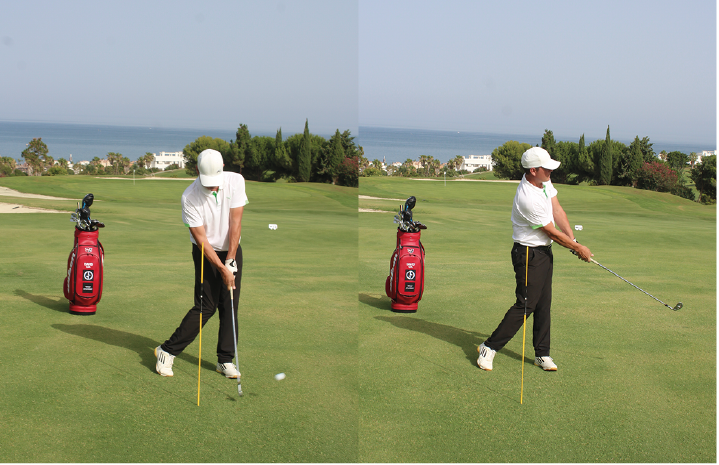I customarily like to write a brief general introduction about the game before continuing with a new lesson, and on this occasion I think it is timely to offer advice about playing golf at this time of the year.
When we play golf with such high temperatures it is extremely important to protect ourselves. Needless to say you should avoid hours of extreme heat when practising or going out to play. It is also very important to hydrate as much as you can and to try to find as much shade as possible on the course when you are waiting for the group in front of you or your playing partners.
Also, take a towel with you (always wet) to cool off, and don’t forget a cap or hat. And why not use your umbrella as a parasol?
These are just a few tips that we all should keep in mind so we can enjoy a pleasant day of golf during these high temperatures.
On a technical level, bear in mind that courses at this time of the year are usually harder than usual, and therefore your ball will tend to roll and fly more. You must take this into account when choosing the right club.
Especially in the Andalucía region, courses usually carry out their greens maintenance in June, so during that time it is possible that they will not be very fast, before returning to their normal state – and even better – in a short space of time.
.
This Issue’s Lesson
Where to Place Your Weight During the Swing
How many times have you wondered where you need to place your weight during the backswing or downswing? I'm sure many.
In this lesson I will try to clarify this question, which in general starts with a very common mistake, one that many players need to address.
I will start by explaining how you have to work with your irons, as for the driver it might change slightly.
The main difference is confusing the terms “weight” and “pressure”. I will first clarify this with a brief summary of the most common doubts – then give you some tips and exercises so you can work on these important aspects of the swing.
Lateral Movement
First mistake… The player thinks their weight on the way up has to move to the right side. This will be outside the axis and it will be very difficult to hit the ball well, as the swing will have to be compensated on the way down by moving to the left side.
Weight on the Left Side
Second mistake… If the player thinks their weight must always be on the left side, and they start their swing moving to that side, their body will move in the opposite direction to the club throughout the swing. This will generate less speed and in most cases they will have to recover their balance by hitting exaggeratedly on the right side. This error is also very common and we call it “tilt”.
The Key: Work on Pressure During the Swing
Let's now talk about the pressure you place on the ground with your feet, because this is where the key really lies.
Position yourself with a neutral stance, placing a little more pressure on the ground with your left foot, with the ball in the centre, and start moving the club – slowly making less than half a swing.
Doing this exercise slowly you will not notice any pressure changes. However, if you start to speed up the movement, you will notice that the pressure increases on your right foot on the ground as you bring the club up and on your left foot as you bring the club down.
.
.
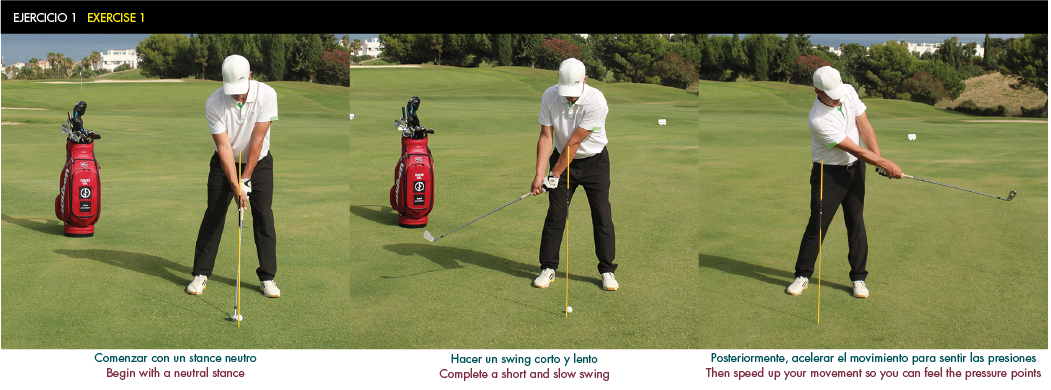
Exercise 1
What You Feel at the Start of Your Swing
- Stand with a neutral stance, swinging the club slowly (mid-iron 6-7) from side to side without going past mid-swing.
-Speed up this movement until you begin to feel a change in pressure.
-When you feel this, start your backswing, making sure the pressure at impact is higher on the left side.
As you will see, it is not about shifting or tilting, because both are common mistakes and are not natural movements. The correct and natural movement is that most of the time your weight stays in the same place: i.e. centred.
This will be the correct feeling for the start of your backswing, as you maintain your axis centred – without shifting or tilting.
.
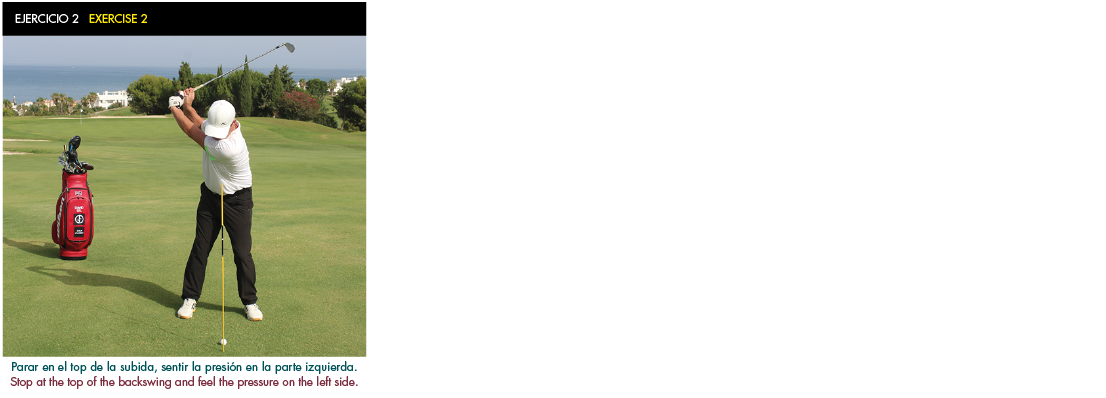
Exercise 2
Weight and Pressure at the Top of the Backswing
Practise a backswing slowly with a guiding shaft in the centre of your body and, when you reach the top by stopping the club, check where you have more pressure. If you don't exert more pressure on the left side, you will need to correct this to improve.
How the Length of the Backswing Influences Weight
The length of the backswing is another important factor to take into account. Every day you can watch Tour players with shorter backswings. However, the important thing is that you are able to keep your axis centred and the angles of the body well positioned so that you attack the ball solidly, looking for movement that is as natural as possible and easy for you specifically.
After doing this exercise, check if the sensation you have at the end is similar to the one you normally have when you play out on the course.
.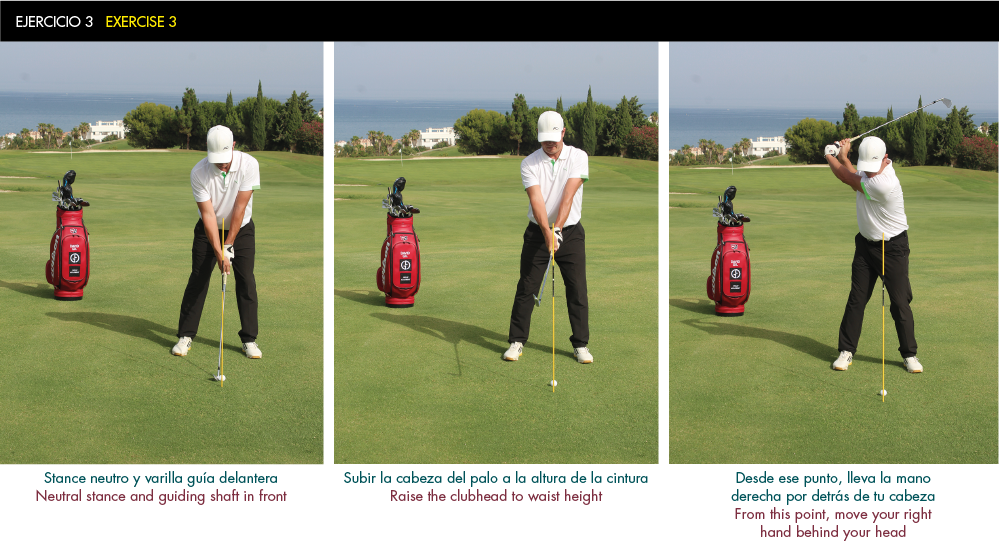
.
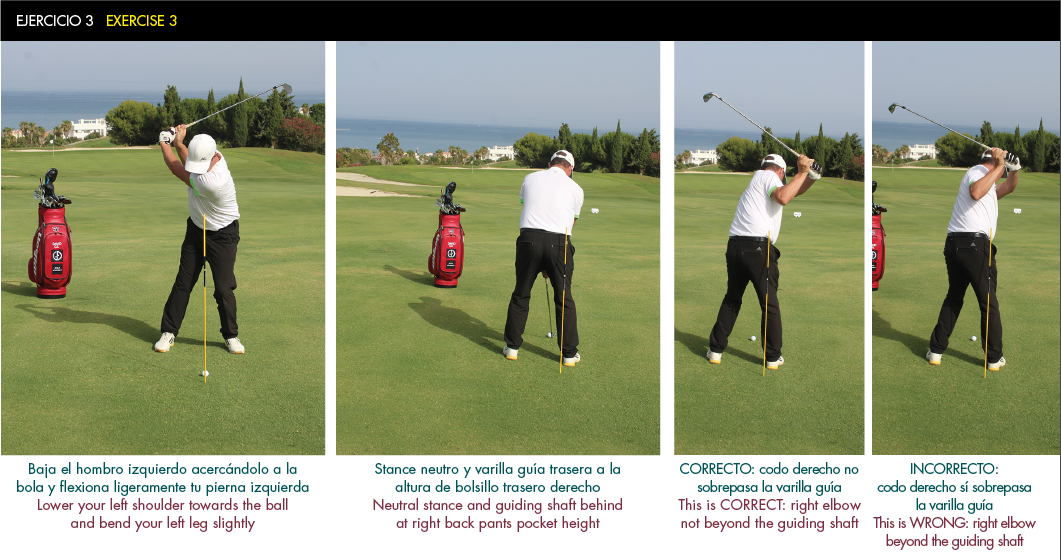 EJERCICIO 3
EJERCICIO 3
Exercise 3
The Backswing (steps to follow)
- With a medium club (6 or 7 iron) place a guiding shaft on the ground right in the middle and a second shaft stuck in the ground at the level of your right back pants pocket.
- Raise the club to your waist while keeping the head of the club in the air.
- Turning your shoulders, bring your right hand behind your head.
- Your right elbow will not be able to go beyond the club previously placed just behind you.
- Lowering your shoulders, bend your left leg a little more to exert pressure at that point.
For this exercise, I recommend recording yourself from behind with a mobile device in slow motion to see if your right elbow passes this point on the way up or if it stays in the correct position.
This would be the perfect posture, with the right pressure during the backswing, and it will help you when attacking the ball using the right angles.
Lowering the Club
Pressure is very important because, if you don’t apply it at the correct points, impacts will not be optimum. That is why I am expanding this lesson with another exercise where you can check if you are doing this correctly.
.
.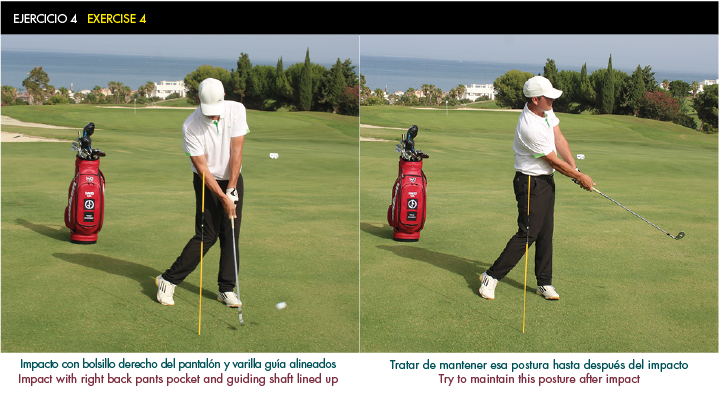
Exercise 4
Correct Posture and Pressure at Impact
In the previous exercise we worked on the correct stance during your backswing, the length of the swing and the pressure points. Using the same shaft that marked the centre of your stance try to:
- Without the ball, swing down slowly and check that at the point of impact (where the shaft is) the right pocket of your pants is at the height of the guiding shaft.
-That pressure is maintained on your left foot.
I strongly recommend you work on these important exercises. They may require some extra effort at the beginning, especially for players who are not experienced or who have been making these mistakes for a long time, but I am sure that, when you practise for a good while, your game will improve significantly.
I would like to express my appreciation to Doña Julia Golf for helping to prepare the photographic material for this feature, on the 12th hole.



